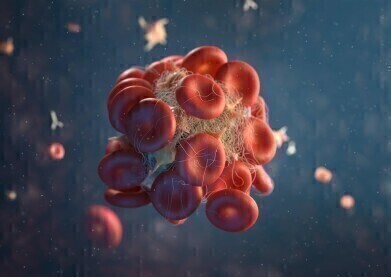-
 Thrombosis clot (Credit University of Birmingham)
Thrombosis clot (Credit University of Birmingham)
News
Device offers more realistic study of Blood Clot Formation
May 05 2023
Scientists at Birmingham University, UK, have developed a vein–on-a-chip model for use in research for understanding mechanisms of blood clot formation, replacing the need for animals in some studies.
Development of the device, a tiny channel including valves to ensure correct blood flow direction, was led by Dr Alexander Brill from the Institute of Cardiovascular Sciences together with Drs Daniele Vigolo and Alessio Alexiadis from the School of Chemical Engineering.
“The device is more advanced than previous models because the valves can open and close, mimicking the mechanism seen in a real vein. It also contains a single layer of cells, called endothelial cells, covering the inside of the vessel. These two advances make this vein-on-a-chip a realistic alternative to using animal models in research that focuses on how blood clots form. It is biologically reflective of a real vein, and it also recapitulates blood flow in a life-like manner,” said Dr Brill.
“Organ-on-a-chip devices, such as ours, are not only created to help researchers move away from the need for animal models, but they also advance our understanding of biology as they are more closely representative of how the human body works.”
Using the model, the research team successfully demonstrated the role of a bridge between a molecule called von Willebrand Factor and a surface receptor on platelets called glycoprotein Ib-alpha, one of the basic mechanisms underlying venous clot formation.
Deep vein thrombosis (DVT), the development of blood clots in veins usually in the legs, can prove fatal as clots can detach and travel to the lungs, where it may block blood vessels and cause difficulty in breathing. Mechanisms of deep vein thrombosis require further research to improve clinicians’ understanding and ability to treat or prevent the condition.
“The principles of the 3Rs – to replace, reduce and refine the use of animals in research – are embedded in national and international legislation and regulations on the use of animals in scientific procedures. But there is always more that can be done. Innovations such as the new device created for use in thrombosis research are a step in the right direction,” added Dr Brill.
This research, funded by the NC3R, British Heart Foundation and Wellcome was published in Frontiers in Cardiovascular Medicine.
More information online
Digital Edition
Lab Asia Dec 2025
December 2025
Chromatography Articles- Cutting-edge sample preparation tools help laboratories to stay ahead of the curveMass Spectrometry & Spectroscopy Articles- Unlocking the complexity of metabolomics: Pushi...
View all digital editions
Events
Jan 21 2026 Tokyo, Japan
Jan 28 2026 Tokyo, Japan
Jan 29 2026 New Delhi, India
Feb 07 2026 Boston, MA, USA
Asia Pharma Expo/Asia Lab Expo
Feb 12 2026 Dhaka, Bangladesh


















